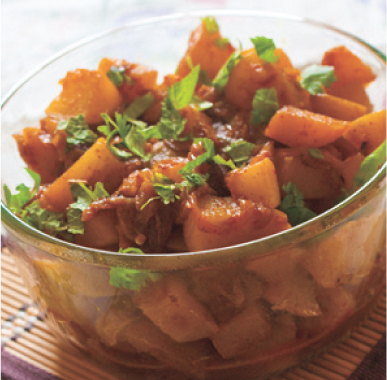Mama’s Punjabi Recipes – Shalgam di Kurry (Turnip Curry)
Very few people actually enjoy eating turnips, because they say they don’t like the slightly radish taste and smell or the texture that is between cooked squash, onion and sweet potato. For this reason, it is really hard to make many people eat shalgam (turnips) without adding more spices to help to remove some of its off-setting taste.
In fact, when my children were little, we would read a short kid’s story called “Shalgam, shalgam Phir Bhi Na Ukada” (The Dear Little Turnip Just Couldn’t be Yanked Out) about a family which all pulls together, down to the family cat and house mouse to pull out a huge turnip from the ground. They still quote it whenever I make turnips, which they associate as an undesirable vegetable! But they have gotten used to eating this dish and the shredded turnips dish.
Turnips are a hardy root vegetable that is tolerant of harsh, extreme weather conditions and is found growing wild in some places like Siberia, where it is cooked in many local dishes. Turnips are high in vitamins and antioxidants and are said to control and reduce the risk of certain cancers and also decrease the chances of diabetes, hypertension and obesity. It is also great for the digestive system.
The most popular way to eat turnips in North India is in a pickle with gajjar (carrots) and gobi (cauliflower). The mustard seed oil, along with fennel seeds and other spices adds tenderness and flavor. In the Punjab, turnips can be cooked shredded or as a curry, but as they cook very easily and quickly, it is important that the curry version does not turn to mush, which is the reason why so many people refuse to eat this dish.
Ingredients:
5 medium shalgam (turnips)
2 medium pyaaz (onion) – peeled and finely chopped
1 tablespoon adrak (ginger) – peeled and finely chopped
2 cloves lasan (garlic) – peeled and finely chopped
1 small tamater (tomato) – soft, cut in cubes
6 tablespoons of vegetable or olive oil
Spices (to taste): namak (salt), mirch (red pepper), haldi (turmeric), dhania (coriander) powder
Directions:
1. Wash and dry the turnips, then peel and cut them into small 1 inch cubes and place them in a bowl of water to keep from turning color.
2. Heat 4 tablespoons of oil over medium heat in a kadai (wok) or skillet, then add the tomato onions, garlic and ginger and stir continuously to make sure it doesn’t burn. The garlic and ginger bring out the full flavor of the turnips. When the mixture is slightly brown, add the spices and stir well.
3. Now throw in the cubed turnips and add to the masala, stirring thoroughly, adding a half cup of water and cover over medium heat. Check frequently if the turnips have become tender.
4. When they are quite tender, add a cup of water to and let the turnips boil for 5 minutes. Now turn the heat to low and let it simmer for 10 minutes so that the curry thickens, stirring occasionally.
5. Turn the heat off and let the pot sit covered for 10 minutes. The shalgam di kurry is ready to eat. It tastes best with tandoori roti or crispy plain paranthas.
Shakuntla Malhotra is a skilled cook of Punjabi dishes made in the old-fashioned style that she learnt as a young woman in her ancestral home in Lyallpur, India before it became part of Pakistan after the Partition in 1947. People have often admired her cooking for its simplicity and taste that comes with each mouthful. Even in her mid-eighties, she continues to cook daily and agreed to share some of her delectable Punjabi recipes.
MAMA’S TIP OF THE WEEK
WHAT TO DO WITH SPOILT MILK
Sometimes, you might find that the milk has gone bad in the refrigerator and has curdled. You could be tempted to throw it away, but there is a silver lining to this, especially if it is whole milk. This is an old Indian cooking trick that many young people here are probably not familiar with, and the older people just can’t be bothered with, but with a little patience and effort you can make use of that bad milk.
Take the bad milk from the jug and pour it into a large pot or wok. Place it over high heat and let it come to a simmer, stirring constantly. Add half a cup of white vinegar and stir some more for 5 minutes. The milk will separate into paneer and a thin, yellowish fluid. Place a soft, porous muslin or cotton cloth over a sieve and secure the edges so that they do not fall in. Now pour the mixture through the cloth and let the liquid drain, catching all the cheese, and let it drain for a few minutes. Gather all the ends of the cloth and tie together, forming a ball with a tight knot and let the ball drain over a pot or in an undisturbed area. Once no more liquid drains, open the cloth and you will have white paneer!


